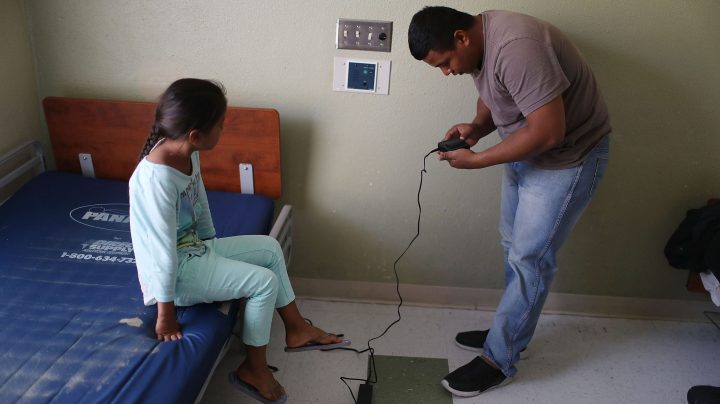
The growing business of immigrant surveillance
The growing business of immigrant surveillance

For five years, Danny, his wife and daughter — all asylum seekers from Honduras — have been under surveillance by a growing electronic monitoring program by Immigration and Customs Enforcement.
Danny described his time under monitoring as “stressful” and “psychologically bad” as he’s been turned away from jobs due to his ankle monitor, panicked about technological glitches and complied with frequent ICE check-ins. He’s asked to use only his first name as he fears retaliation.
He and his wife were tracked through an ICE electronic monitoring program that has more than doubled in size under the Biden administration, according to Syracuse University TRAC data.
The high dollar contracts to run monitoring programs, like the one with ICE, have become a lucrative source of business for private prison companies that are otherwise seeing their industry decline.
For Geo Group, who operates the ICE program, the electronic monitoring product segment jumped from 12% to more than 20% of company revenue in the last year, according to IBISWorld analyst Alex Petridis.
“Clearly there’s demand for this product, but it remains to be seen whether it will have a similar jump in the years coming,” said Petridis, “It’s new technology being used so legislators have yet to regulate it.”
While electronic monitoring has contributed to high rates of case compliance for immigrants awaiting immigration hearings, including many who will ultimately face deportation, advocates have argued that there are less intrusive methods to successfully encourage immigrants to comply with ICE check-ins, send in paperwork and show up to hearings.
For Danny, he became increasingly frustrated and paranoid during his five years under electronic monitoring by Immigration and Customs Enforcement.
In Honduras, he and his wife and eldest daughter fled out of fear that gang members would kill them. They had refused to pay the gang hundreds of dollars of profits weekly from the family’s small businesses. He said he’s grateful they weren’t detained for a long time after crossing the border and initially didn’t mind the ankle monitor on his left foot.
Then came the looks from strangers, fear from co-workers and the bullying from his daughter’s friends about her parents being criminals all because of the ankle monitors.
“We didn’t come here because we wanted to, but because we were obligated to come and they treat us like we came to steal or commit some sort of crime,” he said in Spanish.
As months passed, his ankle monitor battery would last fewer and fewer hours, leading him to become increasingly paranoid. He remembers one night at 3 a.m. waking up to a frantic call from a Geo Group case specialist after his battery died, demanding to know where he is.
Calls like this grew more frequent. Then his lawyer helped him get a seemingly less intrusive option: a monitoring smartphone app called B.I. SmartLINK.
“It’s the same stress, the same headache, the same suffering because the app glitches a lot,” he said.
He got frustrated with the app failing over and over when he would take photos for his check in. And he didn’t trust that the app on his phone wasn’t spying on him — he even refused to talk about politics or immigration around his phone.
“ICE is extracting copious amounts of personal information about people … from their names, address, social security numbers if they have one, to their location, their friends, their family, their associations, their vehicle numbers, their whereabouts,” said Laura Rivera, an attorney with Just Futures Law, “I don’t think the government can be trusted to handle this volume of sensitive data about immigrants and persons in the United States.”
She also said the agency lacks a fair and transparent process for deciding who ends up in the electronic monitoring program. The vast majority of immigrants with pending immigration cases are not being monitored.
She said there also needs to be more clarity on how someone gets shifted down from less intense electronic monitoring, especially as this program has rapidly expanded.
Under the Biden administration the number of immigrant families and individuals being electronically monitored while their immigration cases move through the courts has increased from roughly 87,000 to more than 200,000 active participants, most of them being put on the B.I. SmartLINK smartphone app, according to TRAC and ICE data. Between August 2020 and June 2022 almost 500,000 people were monitored under the government program.
This expansion of electronic monitoring has been a windfall for Geo Group, the second largest private prison company in the country. The company is under a five-year $2.2 billion contract with ICE.
Alex Petridis said it’s likely that other companies are taking notice at a time when the government is moving away from contracting out detention space from private companies and because electronic monitoring services are more profitable than running correctional facilities.
“There’s a lot of less upfront costs and maintenance costs obviously,” he said, though as chip supply chain issues continue and tech ages, profitability could diminish.
Houston ICE officer Edward Kanney said electronic monitoring “is all about mitigating flight risk” for people with pending cases and “it has been a positive” in terms of improving overall case compliance.
On his computer screen he showed the movements of one person with the B.I. SmartLink app over the course of 24 hours. He said ICE was collecting data only to make sure people were staying in the locations they were supposed to.
Besides monitoring movement, B.I. SmartLink app also reminds people about important events like court dates.
“It’s providing migrants themselves with accurate information on a process that can be very confusing and a process that sometimes changes when court dates change,” said former INS commissioner Doris Meissner, an analyst with the Migration Policy Institute.
People under electronic monitoring have a 95% compliance rate for showing up to their final court hearings and nearly 100% compliance for other hearings, according to Immigration and Customs Enforcement data. That’s compared to an 83% overall immigration hearing compliance rate, according to an American Immigration Council review of 11 years of case data.
But some advocates aren’t convinced. The same study showed that simply having attorney led to compliance rates around 96% and didn’t involve a deportation agency.
“They (government officials) are not thinking about how they’re setting up a system that can be weaponized even more by a future anti-immigrant administration,” said ACLU attorney Naureen Shah, who supports community-based case management.
As for Danny, who is still waiting for his asylum case to be heard in immigration court, he regrets the toll this process has taken on his family.
“The level of stress in my home has always been huge,” he said. “My eldest daughter, a year and a half ago, was diagnosed with epilepsy due to the stress that she had.”
He said things have improved since they are no longer under electronic monitoring, but life is far from the “American Dream.”
There’s a lot happening in the world. Through it all, Marketplace is here for you.
You rely on Marketplace to break down the world’s events and tell you how it affects you in a fact-based, approachable way. We rely on your financial support to keep making that possible.
Your donation today powers the independent journalism that you rely on. For just $5/month, you can help sustain Marketplace so we can keep reporting on the things that matter to you.


















